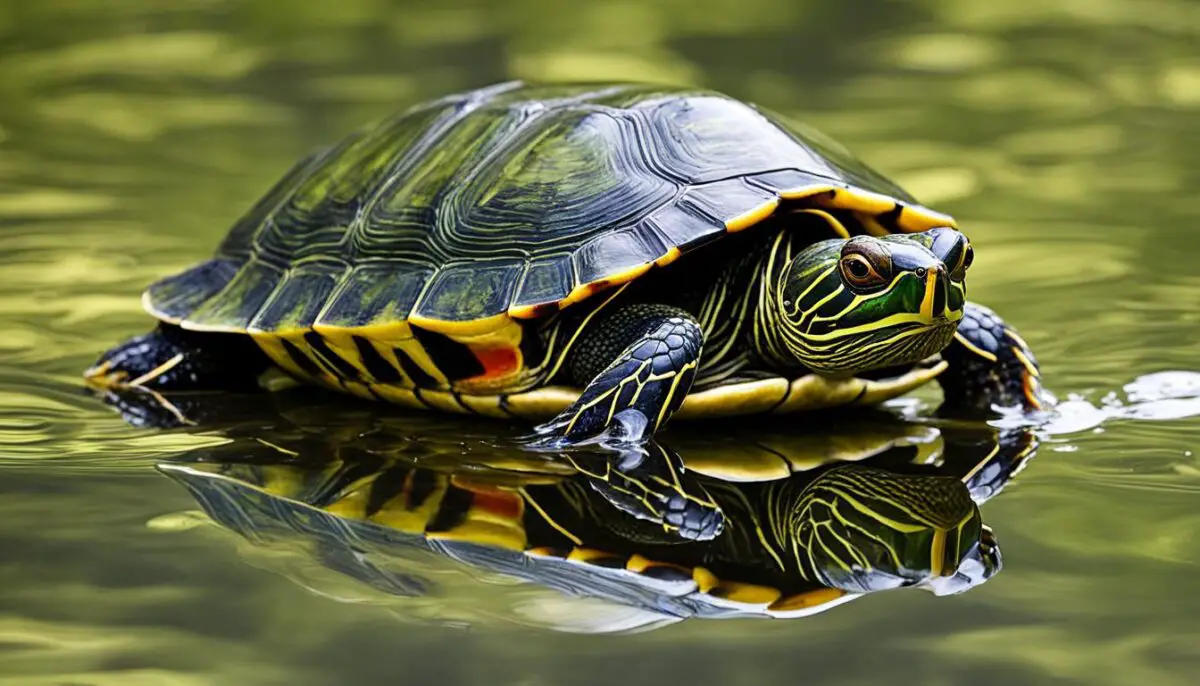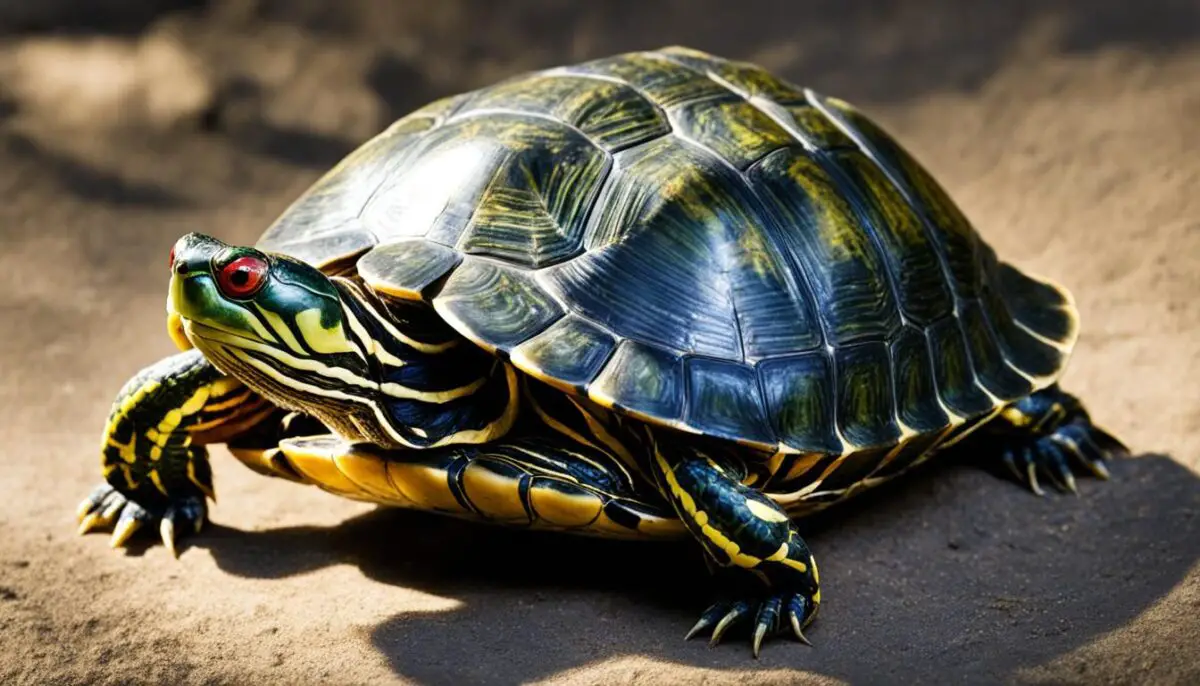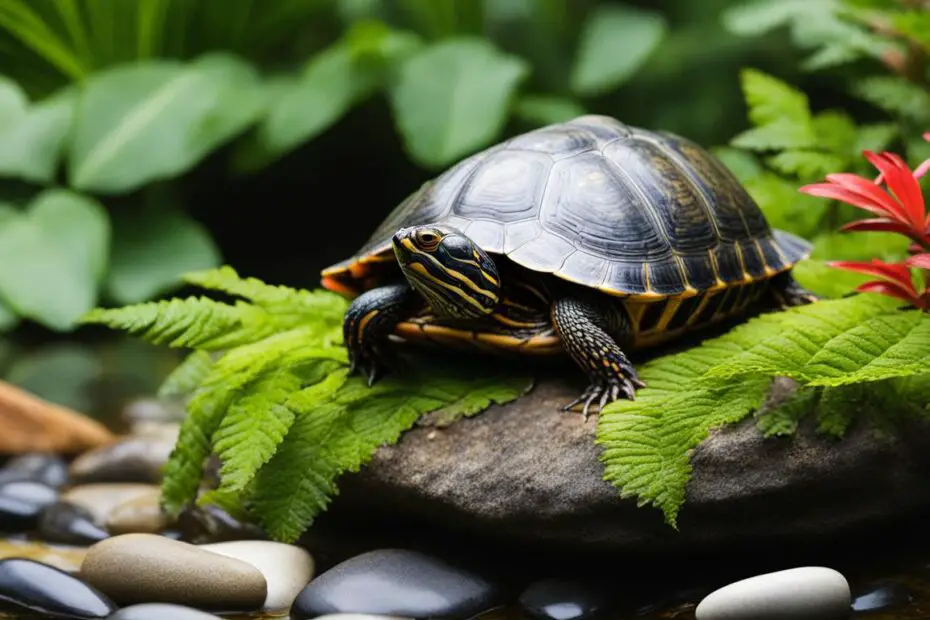Red-eared sliders are fascinating and popular pets known for their distinctive red markings on their ears. While they may seem low-maintenance, it’s important to provide proper care to ensure their shell health and overall well-being. In this article, we will explore the key aspects of red-eared slider shell care, including tank setup, diet, water quality, environmental conditions, and common health issues to watch out for.
Key Takeaways:
- Red-eared sliders require special care to maintain their shell health.
- Tank setup, diet, water quality, and environmental conditions are all crucial for their well-being.
- Proper lighting, a balanced diet, and regular cleaning and maintenance are essential.
- Regular veterinary check-ups help monitor and address any potential health issues.
- With the right care, red-eared sliders can enjoy a long and healthy life.
Setting Up the Right Tank for Your Red-Eared Slider
Proper tank setup is essential for maintaining the shell health of your red-eared slider. Providing the right environment ensures their well-being and allows them to thrive. Here are some key considerations for setting up your red-eared slider shell tank:
- Tank Size: The tank size is crucial for accommodating the growth and activity of your red-eared slider. For hatchlings, a 10-20 gallon tank is suitable, allowing them enough space to move around. However, as they mature, adults require a larger tank that can hold over 100 gallons of water. This will give them ample room to swim and explore.
- Water Level: Maintaining the right water level is important to prevent escapes and ensure the safety of your red-eared slider. The water level should be approximately 6 inches below the top of the tank. This prevents them from climbing out and reduces the risk of injuries or accidents.
- Basking Area: Your red-eared slider needs a stable and accessible basking area in their tank. This area provides a dry and elevated spot for them to rest and bask under a heat lamp or natural sunlight. A floating platform or a sturdy rock can be used to create the basking area.
- Filtration and Water Quality: Good filtration is essential for maintaining the water quality in your red-eared slider shell tank. Invest in a reliable filtration system that can effectively remove waste and debris from the water. Regular water changes should also be conducted to maintain optimal water quality and prevent the buildup of harmful bacteria or toxins.
By setting up the right tank for your red-eared slider, you create a safe and comfortable environment for them to thrive. It’s essential to provide them with ample space, a suitable water level, a dedicated basking area, and maintain good water quality through filtration and regular maintenance.
For more tips on caring for your red-eared slider’s shell health, continue reading the following sections.

“Maintaining clean water is essential for the health and longevity of red-eared sliders. A well-functioning filtration system ensures that harmful substances are efficiently removed from the turtle’s environment.”
Regular cleaning and water changes are necessary to maintain the best water quality. Conducting partial water changes once a week, replacing approximately 25-50% of the tank’s water, helps to remove accumulated waste and replenish clean water. Before refilling the tank, make sure to treat the new water with a dechlorinator to eliminate harmful chemicals.
Promoting a clean tank environment:
- Remove any uneaten food promptly to prevent water contamination.
- Regularly check and clean the tank’s filtration system to ensure its efficiency.
- Monitor water parameters such as ammonia, nitrite, and nitrate levels using appropriate test kits.
- If necessary, adjust water conditions using water conditioners and stabilizers to maintain optimal water quality.
Dirty water can lead to shell problems and other health issues for red-eared sliders, including bacterial infections and shell rot. By prioritizing water quality and cleanliness, you can contribute to the overall well-being and shell health of your cherished pet.
Providing the Right Environmental Conditions for Your Red-Eared Slider
When it comes to the shell health of your red-eared slider, providing the right environmental conditions is essential. These conditions include maintaining the correct water temperature, ensuring appropriate lighting, and creating a suitable habitat for your turtle.
Water Temperature
The water temperature in your red-eared slider’s tank plays a vital role in their shell health. The ideal range for the water temperature is between 75-86°F. This temperature range mimics their natural habitat and promotes overall well-being. It’s important to use a reliable aquarium thermometer to monitor the water temperature regularly and make any necessary adjustments.
Basking Area Temperature
In addition to the water temperature, your red-eared slider needs a basking area with the right temperature to maintain shell health. The basking area should have a temperature between 85-90°F. This warmth allows the turtle to regulate its body temperature, promote digestion, and absorb essential UV rays for shell health.
Lighting
Full-spectrum UV lighting is crucial for your red-eared slider’s shell health. This type of lighting helps them produce Vitamin D3, which is essential for the absorption of calcium. Choose a UVB bulb specifically designed for reptiles and follow the manufacturer’s instructions for proper placement and duration of lighting. UVB bulbs should be replaced regularly, as their effectiveness diminishes over time.

Habitat
The habitat for your red-eared slider should provide a comfortable and safe space for them to thrive. It should include a basking area where the turtle can emerge from the water to bask under the warmth of the UV lighting. The basking area should be large enough for the turtle to fully extend its limbs and rest comfortably.
Additionally, consider providing natural elements and hiding spots in the habitat to stimulate your turtle’s natural behaviors. This can include rocks, logs, and plants. However, make sure these elements are safe and non-toxic for your turtle.
By ensuring the proper water temperature, adequate lighting, and a suitable habitat, you can create the optimal environment for your red-eared slider’s shell health.
Monitoring and Addressing Common Health Issues in Red-Eared Sliders
Red-eared sliders, like any other turtle species, can experience various health issues that can negatively impact their shell health. It is important for turtle owners to be aware of these potential problems and take proactive measures to prevent and address them promptly. Regular monitoring, veterinary check-ups, and proper care are essential for maintaining the overall well-being of your red-eared slider.
Common Health Issues in Red-Eared Sliders
Red-eared sliders are prone to several health issues, which can manifest in their shells. These common health issues include:
- Shell rot: A fungal or bacterial infection that causes the shell to become soft, discolored, and develop a foul smell.
- Metabolic bone disease: A condition resulting from calcium and vitamin D3 deficiencies, leading to weak and deformed shells.
- Respiratory infections: Infections that primarily affect the respiratory system, often caused by poor water quality or inadequate basking area.
- Eye problems: Inflammation, infections, or injuries that can affect the eyes, leading to swelling, discharge, or even blindness.
- Egg binding in females: A condition where female turtles are unable to lay their eggs, potentially causing discomfort and serious health risks.
By being observant and proactive, you can catch these health issues early on and seek appropriate veterinary care.
Monitoring Your Red-Eared Slider’s Health
Regular monitoring of your red-eared slider’s behavior, appetite, and shell condition is crucial to identify any potential health problems. Pay attention to the following signs:
- Changes in appetite or sudden weight loss.
- Abnormal or labored breathing.
- Swollen or reddened eyes.
- Soft or discolored areas on the shell.
- Unusual behavior or lethargy.
- Difficulty laying eggs in female turtles.
If you notice any of these signs or suspect a health issue, consult a veterinarian experienced in reptile care as soon as possible.
“Regular monitoring, veterinary check-ups, and proper care are essential for maintaining the overall well-being of your red-eared slider.”
Addressing Health Issues in Red-Eared Sliders
If your red-eared slider develops a health issue, it’s important to seek appropriate veterinary care. Treatment options may vary depending on the specific health problem but can include medication, proper diet adjustments, environmental modifications, and supportive care.
Additionally, maintaining optimal tank conditions, such as proper filtration, regular water changes, and providing a suitable basking area, can help prevent many common health issues.
https://www.youtube.com/watch?v=xupG9giC7aM
Remember, prevention is key when it comes to the health of your red-eared slider. By providing a well-balanced diet, maintaining appropriate tank conditions, and being proactive in monitoring their health, you can help ensure your red-eared slider enjoys a healthy and happy life.
Conclusion
Proper care is crucial for maintaining the shell health of your red-eared slider. By ensuring the right tank setup, providing a balanced diet, maintaining water quality, and creating the right environmental conditions, you can help your turtle thrive. Regular maintenance and monitoring of their health are key to preventing and addressing any shell problems that may arise. Remember, with the right care and attention, your red-eared slider can enjoy a long and healthy life.
For the best results, make sure your red-eared slider’s tank is suitable for their size and includes a basking area for them to soak up UV rays. A diet that includes a variety of animal and plant-based items, in the right proportions, will promote optimum shell health. Regular water changes and proper filtration will help maintain water quality, preventing any shell-related issues.
Lastly, ensure that the environmental conditions in the tank mimic their natural habitat, including the right temperatures and lighting. By providing these essentials and keeping a watchful eye on your red-eared slider, you can ensure their well-being and longevity. Remember, with care and attention, your turtle can enjoy a happy and healthy life.
FAQ
How do I care for the shell health of my red-eared slider?
To care for the shell health of your red-eared slider, you need to provide proper lighting, diet, and continuous cleaning and maintenance. It’s important to ensure the right tank setup, water quality, and environmental conditions to prevent shell problems and ensure overall health.
What size tank should I have for my red-eared slider’s shell health?
For hatchlings, a 10-20 gallon tank is suitable, while adults require a tank that can hold over 100 gallons of water. The tank should have a water level 6 inches below the top to prevent escapes and include a stable area for the turtle to bask.
What should I feed my red-eared slider for shell health?
Red-eared sliders require a balanced diet. While commercial turtle pellets can be a base, it’s important to supplement with a variety of other animal and plant-based items. Juveniles should have up to 40% protein in their diet, while adults can have 25-50% protein. Leafy greens, vegetables, and occasional fruits should also be included.
How do I maintain water quality for my red-eared slider’s shell health?
Good filtration and regular water changes are necessary to maintain water quality for your red-eared slider. The tank should have a filtration system that can handle the waste produced by the turtles. Regular cleaning and water changes are essential to prevent shell problems and other health issues.
What environmental conditions are best for my red-eared slider’s shell health?
Red-eared sliders require a water temperature between 75-86°F, with a basking area temperature of 85-90°F. Full-spectrum UV lighting is also essential to mimic natural sunlight and promote overall health. The habitat should include a basking area where the turtle can emerge from the water to absorb heat and UV rays.
What are common health issues in red-eared sliders and how can I address them?
Common health issues in red-eared sliders include shell rot, metabolic bone disease, respiratory infections, eye problems, and egg binding in females. Regular veterinary check-ups, proper care, and monitoring of behavior, appetite, and shell condition can help prevent and address these health issues.
